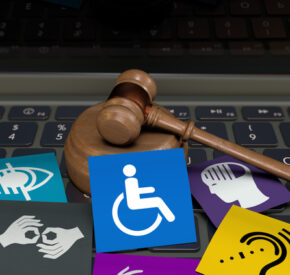DeafSpace and an Equal Experience
Expanding accessibility to include comfort and peace of mind

The goal of accessibility is to design in a way that provides an equal experience to the user, regardless of their ability. On the digital side, that means making sure that everyone has access to the same information. An accessible design concept for a physical environment has a different goal; giving users access to the same level of comfort. This isn’t something we had previously considered, and doing so deepened our definition of what an ‘equal experience’ was.
The concept is called the DeafSpace Project (DSP). The DSP was created in 2005 by Architect Hansel Bauman in collaboration with Gallaudet University. It provides a set of guidelines for the physical environment that are based on common practices in the Deaf community, like rearranging furniture and adjusting lights and window shades, to create an optimal environment for signed communication. The guidelines are comprehensive collection of over one hundred and fifty innovative DeafSpace design solutions that optimize the five key interactions between Deaf individuals and their surroundings. Here are the key five:
Sensory Reach
Sensory reach refers to one’s ability to establish and maintain a sense of spatial awareness. People who are deaf or hard of hearing rely on various visual and tactile cues to alert them to what’s going on around them. Strategically placed mirrors and glass walls make it easier for someone to see what is going on all around them, and assist with wayfinding too.
Space and Proximity
Since American Sign Language (ASL) is a visual language, the space between two people is greater than if they were communicating using a spoken language. Both people need to be able to see their partners full signing space, including their face, hands, and arms. As the number of people in the conversation increases, the space required increases too, so that everyone has enough room to participate.
Mobility and Proximity
Having adequate room to talk is just as essential when people are on the move. It’s important to provide enough space for people to talk to each other while getting safely from one place to another. Designing wide hallways and using ramps and automatic doors are examples of ways that buildings can be optimized for those using ASL.
Light and Color
Communicating using a spoken language becomes more difficult when audio distractions are present. The same concept exists when using ASL, but with light instead of sound. Improper lighting causes glare, shadows, and other distractions. Lighting should be used to help diffuse the light in a room, and reduce eye strain and fatigue. Color has a role to play as well, and is frequently used to contrast against skin tones, making signs easier for people to see and read.
Acoustics
You may be surprised to learn that the DSP included a section on acoustics. Certain noises and reverberations are distracting and even painful to individuals using assistive technology like cochlear implants and hearing aids. Designs should focus on minimizing unwanted background noises that can be caused by certain building materials and electrical appliances.
Learning about what was possible through these physical design considerations helped me think beyond simply providing content. An equal experience isn’t just about access to the same information, it’s about access to peace of mind too. Whether that is feeling stable where you are, feeling safe to move around, or feeling free to communicate.





